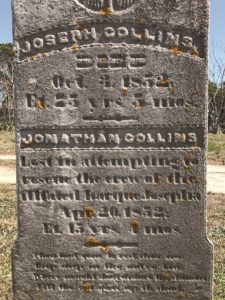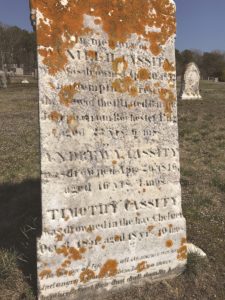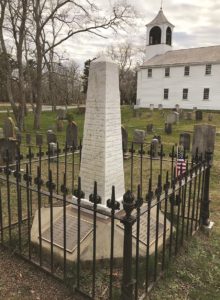TRURO — The fog was thick on Monday night, April 19, 1852 — what sailors call “pea soup.” Gale winds blew from the east. At midnight, after making Cape Ann Light, Capt. Cawsey of the British bark Josepha, bound for Boston, stood off on a southeasterly course, eventually tacking and running in toward Cape Cod. The approach was too close, and by Tuesday afternoon, as daylight was fading, the Josepha had struck the outer bar just north of Highland Light.
Despite the vessel’s 600-ton burden and her cargo of railroad iron, the mountainous curlers toyed with the grounded Josepha, pushing her over the outer bar and onto the inner bar where she began to break apart. There — in those pre-lifesaving service days — she floundered until three boys walking the beach heard the heartrending cries of 16 desperate crew members. They alerted Enoch Hamilton who, in December 1850, had become keeper of the Highland Light.

As Hamilton assembled lifesaving equipment and delivered it down the sand cliffs to the beach, fires were lit to reassure the suffering crew that help was at hand. Townspeople from Pond Village made their way to the bluffs, among them Jonathan Collins and Daniel H. Cassity. Procuring a dory that belonged to the lighthouse — and despite remonstrances that the task at hand was too dangerous — the two launched into the heavy fog and surf. They were able to come within yards of the wrecked vessel and speak with crew members before their dory capsized. Both vanished into the sea. Collins, 45, left a wife and three children. Cassity, whose body washed ashore at Provincetown, was 23 and had married Sarah Rich Paine less than two months earlier.
As night descended and violent seas continued to pound the Josepha, the cries that had penetrated the fog ceased. It seemed that everyone had perished. But Keeper Hamilton, unwilling to concede the worst, returned to the beach later in the evening and found two crew members barely alive, cast ashore on pieces of debris. Carried up the 100-foot cliff, the survivors were cared for at the lighthouse.
Through the efforts of Solomon Davis, a prominent Truro resident, word of the valiant lifesaving attempt by Collins and Cassity reached the British consul in Boston. Her Majesty’s government provided a gratuity of 50 pounds sterling to each of the widows, while the people of Boston raised another $375.50.
Jonathan Collins, the son of Joseph and Jerusha (Snow), shares a headstone with his father in Truro’s Methodist Cemetery, established in 1826 when the first Methodist meetinghouse was built on the Hill of Churches at the intersection of Bridge and Meetinghouse roads. The headstone and family plot tell Jerusha’s sorrowful story. She lost her husband just months after Jonathan’s death, as well as four other children, including another son lost at sea in 1835.

Little is known of Daniel H. Cassity, whose marriage record says he was born in Berwick, Maine. In 1850 he was living in the household of Edward Kilburn, immediate neighbors of his future wife, 13-year-old Sarah, who was living with her widowed mother. Sarah’s father, Gamaliel Smith Paine, and her 14-year-old brother, Henry, had been lost at sea aboard the Dalmatia during the October 1841 gale that claimed the lives of 57 Truro men and boys. A marble obelisk in the Congregational Cemetery is a melancholy reminder of what historian Shebnah Rich aptly called the “most appalling calamity that ever befell Truro.”
Equally heartbreaking is the story etched on Daniel Cassity’s headstone in the Old North Cemetery. Also on the stone are the names of his younger brothers Andrew and Timothy. Andrew, born in 1831, was a crew member on the schooner Brenda. On April 26, 1847, while anchored at Provincetown, Capt. Samuel Coan and nine of his crew were sailing across the harbor in a smaller boat to Pond Village when they capsized in heavy seas. Six of the crew, including Andrew Cassity, drowned within sight of their homes. All the bodies were recovered.
Timothy Cassity, born in 1833, was a crew member aboard the schooner Eleanor M. Shaw when he drowned in the Bay of Chaleur off Prince Edward Island during the Yankee Gale of 1851, the worst marine disaster in P.E.I. history. What began as a warm and cloudy afternoon on Friday, Oct. 3 — 10 years to the day after the October 1841 gale — exploded into a maelstrom that lasted two days, devastating the New England mackerel fleet. A post-War of 1812 treaty with Great Britain allowed American vessels to fish the lucrative waters of the Gulf of St. Lawrence where, each July, hundreds of Yankee sails began to congregate. One newspaper report noted that, at night, when the fleet was safely anchored, the lighted lanterns hanging from the shrouds appeared like a “huge city lying in repose.”

On Oct. 3, the fleet was caught by surprise as the storm swept across the gulf. By the time it ended, the north shore of Prince Edward Island had become a graveyard, the loss of life and property defying belief. For days on end, the sea surrendered bodies and tangled wreckage. The precise toll cannot be known, but 150 vessels and 250 lives may have been lost.
The people of Truro, all too accustomed to stoically accepting their fate, were hopeful when an initial report indicated that the Eleanor M. Shaw had been seen during the storm and was thought to be safe. It was not to be. In the weeks to come, nothing was heard of the 13-member crew. Next to the grave of his young wife, Eliza, whom he had lost in childbirth in 1849, an obelisk in Snow Cemetery remembers the lost crew and its captain, Thomas W. Shaw, who named the Eleanor M. Shaw for his young daughter. Such are the fates of families.



